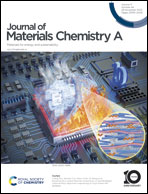Solar light selective-harvesting eco-friendly colloidal quantum dots for transparent luminescent solar concentrators†
Abstract
Luminescent solar concentrators (LSCs) constructed using colloidal quantum dots (QDs) have emerged as a promising and cost-effective solution for transparent photovoltaics. However, the efficiency of these LSCs in converting sunlight to electricity often remains low due to limited quantum efficiency and significant reabsorption losses associated with the QDs. Furthermore, the majority of high-efficiency LSCs incorporate QDs containing heavy metals, curtailing their potential for widespread commercialization. Here, we have developed white-emitting CuGaS2/ZnS and its optical characteristics are adeptly tailored through manipulation of the ZnS shell. The optimal configuration of CuGaS2/ZnS demonstrates an impressive photoluminescence quantum yield of 80% and an extensive Stokes shift of ∼190 nm. These QDs are integrated in a polymer matrix to produce LSCs with dimensions of 5 × 5 × 0.2 cm3. Under standard illumination conditions of one sun AM 1.5G (100 mW cm−2), these LSCs exhibit an optical efficiency of 1.7%, average visible transmittance of ∼75% and color rendering index of 91.6. To improve the solar light harvesting, we constructed a tandem LSC, with CuGaS2/ZnS QD-LSC as the top layer and near-infrared-active AgInS2/ZnS QD-LSC was developed as the bottom layer. The optical efficiency could reach 4.4%, which underscores the potential of these environmentally friendly core/shell QDs for cost-effective transparent solar conversion applications.

- This article is part of the themed collection: Celebrating the scientific accomplishments of RSC Fellows


 Please wait while we load your content...
Please wait while we load your content...